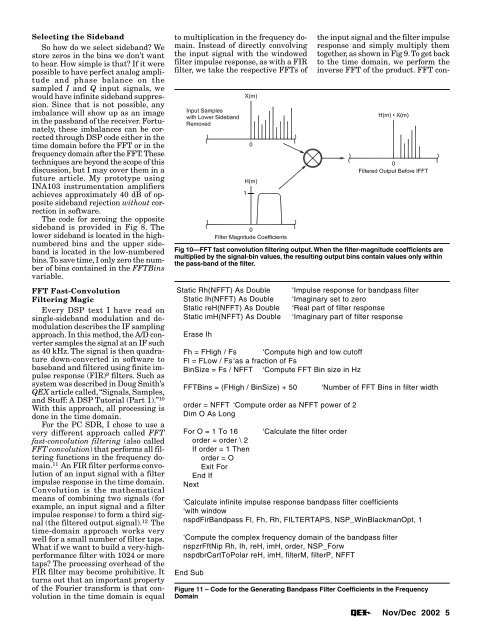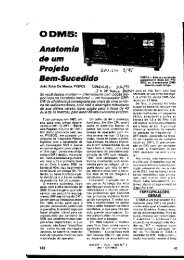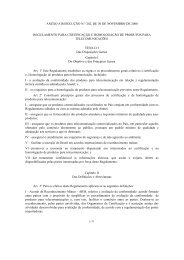A Software Defined Radio for the Masses, Part 3
A Software Defined Radio for the Masses, Part 3
A Software Defined Radio for the Masses, Part 3
Create successful ePaper yourself
Turn your PDF publications into a flip-book with our unique Google optimized e-Paper software.
Selecting <strong>the</strong> Sideband<br />
So how do we select sideband? We<br />
store zeros in <strong>the</strong> bins we don’t want<br />
to hear. How simple is that? If it were<br />
possible to have perfect analog amplitude<br />
and phase balance on <strong>the</strong><br />
sampled I and Q input signals, we<br />
would have infinite sideband suppression.<br />
Since that is not possible, any<br />
imbalance will show up as an image<br />
in <strong>the</strong> passband of <strong>the</strong> receiver. Fortunately,<br />
<strong>the</strong>se imbalances can be corrected<br />
through DSP code ei<strong>the</strong>r in <strong>the</strong><br />
time domain be<strong>for</strong>e <strong>the</strong> FFT or in <strong>the</strong><br />
frequency domain after <strong>the</strong> FFT. These<br />
techniques are beyond <strong>the</strong> scope of this<br />
discussion, but I may cover <strong>the</strong>m in a<br />
future article. My prototype using<br />
INA103 instrumentation amplifiers<br />
achieves approximately 40 dB of opposite<br />
sideband rejection without correction<br />
in software.<br />
The code <strong>for</strong> zeroing <strong>the</strong> opposite<br />
sideband is provided in Fig 8. The<br />
lower sideband is located in <strong>the</strong> highnumbered<br />
bins and <strong>the</strong> upper sideband<br />
is located in <strong>the</strong> low-numbered<br />
bins. To save time, I only zero <strong>the</strong> number<br />
of bins contained in <strong>the</strong> FFTBins<br />
variable.<br />
FFT Fast-Convolution<br />
Filtering Magic<br />
Every DSP text I have read on<br />
single-sideband modulation and demodulation<br />
describes <strong>the</strong> IF sampling<br />
approach. In this method, <strong>the</strong> A/D converter<br />
samples <strong>the</strong> signal at an IF such<br />
as 40 kHz. The signal is <strong>the</strong>n quadrature<br />
down-converted in software to<br />
baseband and filtered using finite impulse<br />
response (FIR) 9 filters. Such as<br />
system was described in Doug Smith’s<br />
QEX article called, “Signals, Samples,<br />
and Stuff: A DSP Tutorial (<strong>Part</strong> 1).” 10<br />
With this approach, all processing is<br />
done in <strong>the</strong> time domain.<br />
For <strong>the</strong> PC SDR, I chose to use a<br />
very different approach called FFT<br />
fast-convolution filtering (also called<br />
FFT convolution) that per<strong>for</strong>ms all filtering<br />
functions in <strong>the</strong> frequency domain.<br />
11 An FIR filter per<strong>for</strong>ms convolution<br />
of an input signal with a filter<br />
impulse response in <strong>the</strong> time domain.<br />
Convolution is <strong>the</strong> ma<strong>the</strong>matical<br />
means of combining two signals (<strong>for</strong><br />
example, an input signal and a filter<br />
impulse response) to <strong>for</strong>m a third signal<br />
(<strong>the</strong> filtered output signal). 12 The<br />
time-domain approach works very<br />
well <strong>for</strong> a small number of filter taps.<br />
What if we want to build a very-highper<strong>for</strong>mance<br />
filter with 1024 or more<br />
taps? The processing overhead of <strong>the</strong><br />
FIR filter may become prohibitive. It<br />
turns out that an important property<br />
of <strong>the</strong> Fourier trans<strong>for</strong>m is that convolution<br />
in <strong>the</strong> time domain is equal<br />
to multiplication in <strong>the</strong> frequency domain.<br />
Instead of directly convolving<br />
<strong>the</strong> input signal with <strong>the</strong> windowed<br />
filter impulse response, as with a FIR<br />
filter, we take <strong>the</strong> respective FFTs of<br />
Fig 10—FFT fast convolution filtering output. When <strong>the</strong> filter-magnitude coefficients are<br />
multiplied by <strong>the</strong> signal-bin values, <strong>the</strong> resulting output bins contain values only within<br />
<strong>the</strong> pass-band of <strong>the</strong> filter.<br />
Static Rh(NFFT) As Double ‘Impulse response <strong>for</strong> bandpass filter<br />
Static Ih(NFFT) As Double ‘Imaginary set to zero<br />
Static reH(NFFT) As Double ‘Real part of filter response<br />
Static imH(NFFT) As Double ‘Imaginary part of filter response<br />
Erase Ih<br />
Fh = FHigh / Fs ‘Compute high and low cutoff<br />
Fl = FLow / Fs‘as a fraction of Fs<br />
BinSize = Fs / NFFT ‘Compute FFT Bin size in Hz<br />
FFTBins = (FHigh / BinSize) + 50 ‘Number of FFT Bins in filter width<br />
order = NFFT ‘Compute order as NFFT power of 2<br />
Dim O As Long<br />
For O = 1 To 16 ‘Calculate <strong>the</strong> filter order<br />
order = order \ 2<br />
If order = 1 Then<br />
order = O<br />
Exit For<br />
End If<br />
Next<br />
‘Calculate infinite impulse response bandpass filter coefficients<br />
‘with window<br />
nspdFirBandpass Fl, Fh, Rh, FILTERTAPS, NSP_WinBlackmanOpt, 1<br />
‘Compute <strong>the</strong> complex frequency domain of <strong>the</strong> bandpass filter<br />
nspzrFftNip Rh, Ih, reH, imH, order, NSP_Forw<br />
nspdbrCartToPolar reH, imH, filterM, filterP, NFFT<br />
End Sub<br />
<strong>the</strong> input signal and <strong>the</strong> filter impulse<br />
response and simply multiply <strong>the</strong>m<br />
toge<strong>the</strong>r, as shown in Fig 9. To get back<br />
to <strong>the</strong> time domain, we per<strong>for</strong>m <strong>the</strong><br />
inverse FFT of <strong>the</strong> product. FFT con-<br />
Figure 11 – Code <strong>for</strong> <strong>the</strong> Generating Bandpass Filter Coefficients in <strong>the</strong> Frequency<br />
Domain<br />
Nov/Dec 2002 5











